130 THE GRACEFUL GREYHOUND
THE GRACEFUL GREYHOUND - King of Track and Field
by David Hancock
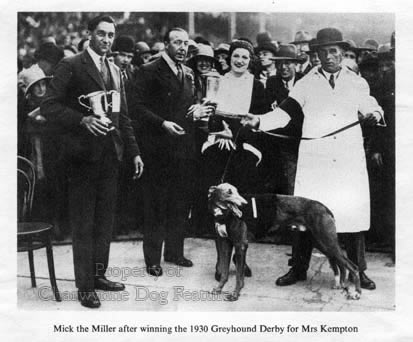 "The Greyhound, the great Hound, the graceful of limb,
"The Greyhound, the great Hound, the graceful of limb,
Rough fellow, tall fellow, swift fellow and slim;
Set them round o'er the earth, let them sail o'er the sea,
They will light on none other more ancient than he."
Those words commendably celebrate the sheer antiquity of the Greyhound but surprisingly pay less attention to the reason for that long history: the dog's quite remarkable speed. Dogs can achieve astounding speeds when serving man. A top sled-dog team can race through snow-clad woods at speeds up to 3.2 minutes a mile--for several days! Blue Cap, the famous Foxhound, is alleged to have covered four miles of Newmarket racecourse in just over eight minutes, in a renowned match race in 1762. That is roughly the speed of a Derby winner at Epsom. But over the sprints there is nothing to match a Greyhound.
A Greyhound can cover 5/16ths of a mile in 30 seconds. In each decade the feats are repeated: in 1932, Ataxy did 525 yards in 29.56 seconds, and, in 1936, 725 yards in 41.69 seconds. In 1971, Dolores Rocket did the 525 yard course in 28.52 seconds. In 1944, Ballyhennessy Seal set what was then a new world record for 500 yards in 27.64 seconds. The legendary Mick the Miller did the 600 yards in 34.01 seconds in 1930. He was spoken of as combining 'tranquillity with trackcraft'. In other words he never wasted energy nervously and used the circuit cleverly. When he died he was found to have a heart weighing 1½ ozs above the normal for a Greyhound of his size.
Of course hounds with a comparable build can also achieve great speed; a 32lb Whippet was once recorded as covering 150 yards in 8.6 seconds. This build is a superb combination of bone and muscle, a unique balance between size/weight and strength and quite remarkable coordination between fore and hind limbs. The Greyhound sprints in a series of leaps rather than running in a strict sense. It is what is termed a 'double-flight' runner, where the feet are all off the ground at the same moment. This is unlike a 'single-flight' animal like the horse which, when racing, always has at least one foot on the ground.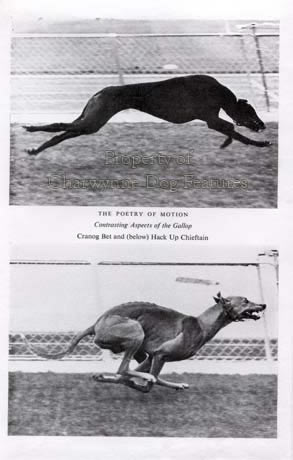
The Greyhound's leaping gait is rooted in quite exceptional extension, especially forward with the hind legs, but also rearwards with the front legs. Anatomically, the most vital elements in such a dog are the shoulders, and their placement, and the pelvic slope, which determines the forward extension of the all-important hind-limbs. That's where the power comes from. It always saddens me to see a sighthound in the show ring displaying upright shoulders and short upper arms, together with a lack of pelvic slope. It is even sadder when such an exhibit is placed by an ignorant judge! I see these faults especially in Afghan Hounds, but also in Salukis, Borzois and Whippets.
I see more correctly-constructed 'Greyhound-Lurchers' than I do show Greyhounds. This is a comment rather than a criticism, because I see many more of the former than the latter. It is worrying however to see a lack of muscle on show Greyhounds and at times a slab-sidedness which affects type as well as function. Sporting breeds must be judged in any ring on their ability to carry out their specific historic function, if not then there is really little point in breeding them. Breed points have no value if a breed loses its precious ability to work. Breeds came to us from a function; the essential thread running through a breed, its breed clubs and its fanciers, is surely that of keeping faith with its functional design.
There is a need too to respect the noble heritage of the Greyhound, this breed is so much more than a 'grey hound'. As with far too many breed titles, with the Tibetan breeds of dog standing out as classic examples, that of the Greyhound is misleading. The inclusion of the letter 'Y' in the Greyhound's breed name gives an immediate hint that this breed earned its title from being a hound distinctly grey. The importance of this mis-spelling lies in the fact that gre-hund meant a 'noble, great, choice or prize-hound'. Three notable authorities: Jesse, Dalziel and Baillie-Grohman, all agree on this; their word is good enough for me. A Welsh proverb stated that a gentleman might be known, and judged, "by his hawk, his horse and his greyhound". By a law of Canute, a greyhound was not to be kept by any person inferior to a gentleman. The greyhound was clearly the companion of noblemen and deserves the more distinctive title of Grehund or noble hound. If we can recognize six breeds of Dachshund, surely we can do justice to the one breed of Grehund.
Confusingly, in the Middle Ages, the word Greyhound was used loosely to refer to such diverse types as the Irish Wolfhound, the Scottish Deerhound and the dainty diminutive Italian Greyhound. Such dogs were the close companions of men involved in war and travel to far-off countries. It is therefore most unwise to link the contemporary breed of Greyhound with portraits of such men. Caius, in 1576, made extensive reference to the greyhound, by name, calling it in Latin: Leporarius, after its hare-hunting employment. He made quite separate reference to the gazehound, quite clearly regarding the latter as a par force hound, not a sighthound. The par force hounds made the hunt into a steeplechase, hunting by sight when their prey was literally within sight, only reverting to scent when hunting in wooded or close country, or on losing sight of their quarry. A gazehound is not a sighthound by another name. 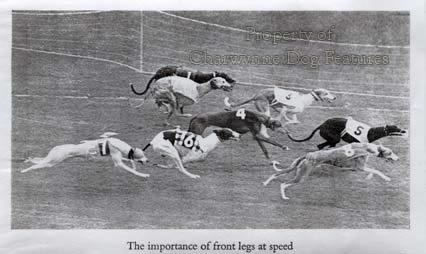
Greyhound researchers usually make much of an early reference to the breed in England by Dame Berners in her "Boke of St Albans". But her memorable description 'Heded like a snake, and necked like a drake. Foted like a cat. Tayled like a Rat' is a clear plagiarism of Gace de la Buigne, written some time previously and not in England. The Ancient Greeks prized their sighthounds, Arrian writing: "...the fast running Celtic hounds are called vertragi in the Celtic language...these have their name from their speed...the best bred of them are a fine sight." The Italian for a Greyhound is veltro, veltre in Old French, from the Celtic word guilter. The Spanish for a Greyhound is galgo, derived from gallicu, a word meaning Gaullish hound.
Today the Galgo is the breed of Spanish Greyhound, just as the Chart Polski is the Polish one and the Magyar Agar the Hungarian version. At a distance all could be confused with a smooth Saluki, a Sloughi or an Azawakh, such is the universal silhouette of a smooth-haired sighthound. (Although the Galgo can feature the rough coat too.) No doubt, the Shilluk Greyhound from the plains of the White Nile in southern Sudan displays the same characteristic phenotype too. In India, there are the Vaghari and Pashmi hounds, the Rajapalayam and Rampur dogs, the Poligar and the Chippiparai dogs, all with clear smooth-haired sighthound anatomies along what we would term greyhound lines. To run fast a dog needs long legs, a long body, great muscular development but not too much weight.
The weight of successful coursing Greyhounds is worth a glance. The renowned Master M'Grath was around 53lbs, Bit of Fashion was 54lbs, Golden Seal, Staff Officer, Guards Brigade, White Collar and Fitz Fife were each around 65lbs but Shortcoming only 49lb. Our show Greyhound has no stipulation regarding weight but its ideal height, for a male dog, is desired at 28-30 inches. A Deerhound dog of 30 inches at the withers would weigh around 100lbs. Does a Greyhound need to be 30" high and approaching a hundredweight? Why does a show Greyhound need to be twice the weight of a successful coursing Greyhound? The American KC standard sets the Greyhound's weight at 65-70lbs for a dog and 60-65lbs for a bitch.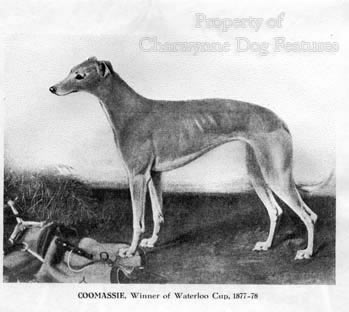
The show Greyhound fanciers might argue that they don't require their hounds to compete at the Waterloo Cup. But that argument is destroyed by the wording of their breed standard. This is a breed clearly designed to run fast, very fast. The section under 'Gait/Movement' asks for a "Straight, low-reaching, free stride enabling the ground to be covered at great speed. Hindlegs coming well under body giving great propulsion." The need for a good slope to the pelvis to allow great forward extension in the hindlegs is not mentioned. Strangely, too, the characteristics of the breed are listed as: Possessing remarkable stamina and endurance. No mention of speed, the principal value of the breed to man down the ages.
The racing Greyhound community is not short of handsome dogs, despite the over-riding priority given to performance. I do have concerns about two aspects of this industry: the number of dogs abandoned to the rescue system and the penalties to so many dogs of bend racing. Hard surfaces and heavier dogs combine to increase the danger of serious injuries to Greyhounds when racing round bends at tracks. Statistics show that over the years, by the time the greyhound Derby final is run each year, at least 40 of the entries will have sustained injury (Sweeney, 1980). I suspect that the heavier dogs receive the highest injury rate. Greyhounds have very vulnerable feet and legs, especially over sun-baked or frozen going. Expecting them to cope with unyielding ground and considerable weight is not wise.
On the credit side, the Greyhound seems resistant to the worrying increase in cranial cruciate ligament rupture in dogs. A study of 821 cases of this disorder found that 77 were Rottweilers but not one a racing Greyhound. The straighter stifle joint of the Rottweiler may play a part in this tendency but it is encouraging to note the greater robustness of the Greyhound's hindlimbs. The Greyhound is less liable to hip dysplasia than any other breed. On the debit side is the worrying sensitivity of the Greyhound to anaesthetic, due to its lack of body fat. It is scarcely surprising for a breed capable of such speed to suffer more injuries in the chase; injuries creating a need for the administration of anaesthetics before treatment do however cause concern in the breed. 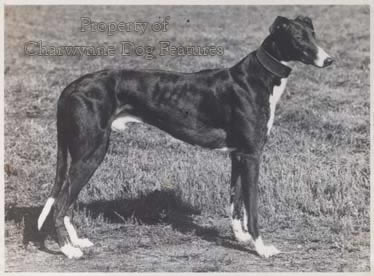
It is significant that in lure-racing in Canada over the 1970s and 80s the most successful hounds were the 'half-and-halfs', i.e. show-track crosses. They were found to have greater endurance and recuperative powers. Track dogs possess greater speed but are not bred to run several races in quick succession. Thirty years ago, in the United States, the Coursing Greyhound of the Year was the American show champion Strider; he was a show-track cross. This would be unthinkable here in the current thinking, more's the pity. Most racing Greyhounds weigh between 64 and 77lbs for dogs and 45 and 55lbs for bitches. In America and Ireland the weights can be higher. But I know of no successful racing or coursing Greyhound of around 100lbs, the weight of some of our show dogs.
Long ago, in the early days of showing, running dogs were shown: the winner of the Waterloo Cup in 1855, Judge, won second prize at the 1862 Islington conformation show. Twenty five years later, Bit of Fashion, dam of the celebrated Fullerton, was exhibited at Newcastle, winning first prize. I find it hard to believe that a specialist Greyhound judge would not admire the powerful hindlimbs, strong sloping shoulders and rounder rib cage of the sporting type. All Greyhounds were once like this; where is the rationale of being attracted to a breed and then wishing to change its shape? Symmetry, gracefulness and beauty are not the essence of a sporting breed.
In the Kennel Gazette of July 1888, the Greyhound critique made mention of 'a showy black, but flat in ribs...' and a bitch of 'beautiful quality and style, but decidedly short of heart room...' Does 'showiness' compensate for flat ribs? Can a sighthound, designed to run very fast, combine beautiful quality with a lack of heart room? Five years later, a critique praised a 'niceish' black bitch with 'rather upright shoulders' (which came second!) and the reserve card winner a 'pretty' dog 'somewhat cow-hocked'. A critique on the breed just a year ago stated that front movement was really bad , with another observing that muscle tone was very hard to find. A recent Crufts critique on the breed commented on the absence of muscle tone in the entry. This is depressing.
The Greyhound is the supreme canine athlete. Our Greyhounds have been exported all over the world because of their athletic excellence. If this deserved fame is to be retained, the show fraternity has a responsibility too, to respect those past sportsmen who strove to develop for us this 'great hound'. It should be a joy rather than a burden to respect this legacy.